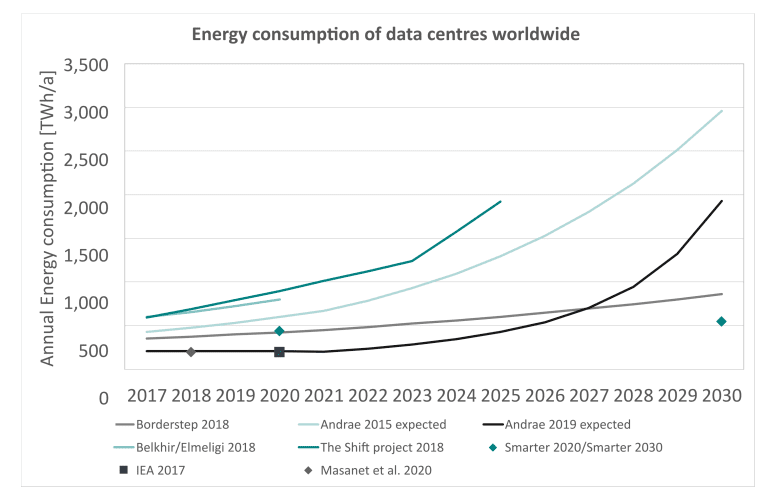The GreenOps methodology is nowadays a must within a sustainable IT strategy. But what does it consist of?
How GreenOps is helping to reduce the cloud’s carbon footprint
In order to maintain their competitiveness, companies are subject to increasingly pressing demands for agility and innovation. CIOs are now seen as service providers for the different activities of the company and cloud computing, with its proposal of mutualization, scalability and flexibility, represents one of the main drivers of digital innovation. For a few years now, there has even been talk of a Move to Cloud strategy (replacing an in-house data center), which has been widely implemented in large companies. However, the Cloud has a significant environmental cost, due to the large amount of energy needed to manufacture and then power the data centers that host Cloud services, as well as the water consumption to maintain its infrastructure.
While the cloud has already been able to develop broad optimization solutions, there are opportunities for improvement at the enterprise level: by following the GreenOps methodology, it is possible to reduce the cloud footprint by 20% or more. This approach identifies underutilized or unused resources, prefers low-carbon locations, optimizes their use and reduces the carbon and environmental footprint of the company’s IT systems, with economic gain.
What is GreenOps ?
GreenOps is a framework for organizations to begin analyzing the environmental consequences of their IT initiatives, while promoting environmental responsibility at all levels of the enterprise. It echoes FinOps, another approach dedicated to the financial dimension of cloud management and cost optimization.
These practices can be applied to a variety of sectors and industries, including utilities, government institutions or manufacturing companies. The benefits of implementing GreenOps practices are many: reduced operating costs, improved corporate reputation and employee engagement, compliance with environmental regulations, and most importantly, helping to fight global warming.

Beyond the illusion of the cloud: The digital pollution it implies
We often talk about the cloud as if data is hosted somewhere in the sky, as its name might poetically suggest. By not thinking of it as a physical entity, many organizations fail to consider the impact it has on the environment. In reality, the cloud is made up of more than 7, 2 million energy-intensive data centers around the world, constantly consuming huge amounts of electricity and millions of gallons of water to cool.
In 2010, cloud data centers accounted for 10% of data center power consumption, a percentage that is expected to rise to 60% by 2025 according to a 2020 European Commission report. By then, cloud data centers’ energy consumption should represent 12% of the energy consumption of all data centers in the European Union.
In other words, we can no longer afford to think of the cloud as an ethereal, invisible entity with no real impact on the environment, when data centers are expected to grow dramatically over the next few years (according to the latest report from the French agency for ecological transition ADEME) as more and more aspects of personal and professional life are digitized.
In a context where the use of the Cloud is becoming more and more consequential within the digital data management market, we need to be able to question cloud service providers on their control of the carbon footprint of their services and their contribution to the goal of global carbon neutrality.
The two lines of action for GreenOps
GreenOps aims to optimize the energy consumption of cloud services by focusing on two key aspects: cloud architectural optimization, which includes both functional design and physical implementation choices of the cloud in the real world, as well as computer code optimization.
IT architecture optimization
To optimize energy consumption in Cloud services, the design of the supporting infrastructure is crucial. GreenOps thus advises choosing energy-efficient computing and networking technologies and properly sizing servers based on actual compute and traffic needs. It can also be useful to ask whether certain services or data really need to be online 24 hours a day. It is indeed possible to temporarily shut down resources during off-peak periods. The choice of locations to deploy the infrastructure is also important: it is recommended to favor regions with a renewable source of electricity and minimizing the environmental impact of air conditioning and cleanroom construction.
<h3>Code optimization and software architecture redesign</h3>
Another focus GreenOps recommends is code optimization. Over time, computing resources have become less expensive and code optimization has been replaced by development cost optimization. However, the need to take into account the environmental impact of software has become essential, especially with the complexity of algorithms. In the same vein, the choice of programming language and tools is also important to optimize memory management. However, it is important to emphasize that optimizing a code in itself does not generally lead to big gains in terms of performance or consumption. It is the redesign of the software architecture and the denormalization that it implies that will have the most impact. Rewriting code in certain languages can also be useful, but it will require training or specialization of teams and the abandonment of existing code.
<h3>Efficiency metrics that complement GreenOps</h3>
GreenOps, however, cannot be considered complete without the inclusion of several other efficiency metrics such as PUE (Power Usage Effectiveness), which reflects the energy efficiency of a data center, and CUE (Carbon Usage Effectiveness), which compares the total CO2 emissions caused by the data center’s total energy consumption and the energy consumption of IT equipment. In addition, the ERF (Energy Reuse Factor), which indicates the percentage of energy reused in relation to the total energy consumed in a data center, is also an important indicator to consider.
A methodology tailored to each organization
As you will have understood, the aim of GreenOps is to provide companies with a method, indicators and tools to effectively and sustainably reduce their ecological footprint in connection with the use of Cloud Computing.
However, it is important to remember that GreenOps is an adaptable approach that can be customized according to the specific needs of companies. It is now the responsibility of each actor to become familiar with this approach, to define the necessary processes to implement it according to the needs, and to promote it within the company to make everyone aware of the environmental impact of digital technology. Putting a GreenOps approach into action can include:
- Integration of tools to monitor energy consumption and the carbon footprint of Cloud services
- An eco-responsible IT architecture of the infrastructure to minimize energy consumption
- A proactive approach to avoid resource waste, which can be combined with FinOPS to optimize operational costs
- A responsible operational model for monitoring the state of the infrastructure and optimizing its energy consumption
- Automation of GreenOps best practices during application design and implementation
- The choice of refurbished or BYOD (Bring Your Own Device) when taking on the need for new digital equipment
Team involvement: the key to the success of the GreenOps methodology
For the GreenOps methodology to be successful, it is not enough to rigorously follow all the best practices. It is also necessary, and even essential, to develop a corporate culture in line with these issues. Beyond the recommendations applied to improve the carbon footprint of the Cloud, the ecological transition of an entire IT infrastructure implies making Responsible Digital a fundamental principle.
It is crucial to integrate decarbonization as well as digital footprint improvement as a KPI (key performance indicator) along with revenue growth and customer satisfaction, in order to inculcate digital sustainability and sobriety in the company’s values. Engaging in a process to improve the environmental footprint of the Cloud can also give new meaning to the activity of IT teams.
In conclusion, implementing a GreenOps approach requires the involvement of everyone in the company. To do this, it is necessary to raise awareness among all stakeholders and to define a relevant and sustainable roadmap. Digital4better, editor of the fruggr solution, helps companies to implement concrete actions (GreenOps practice being part of the action levers and KPIs reported in fruggr) within the organization so that they commit themselves in the long term for a more responsible, ethical and sustainable digital strategy.

